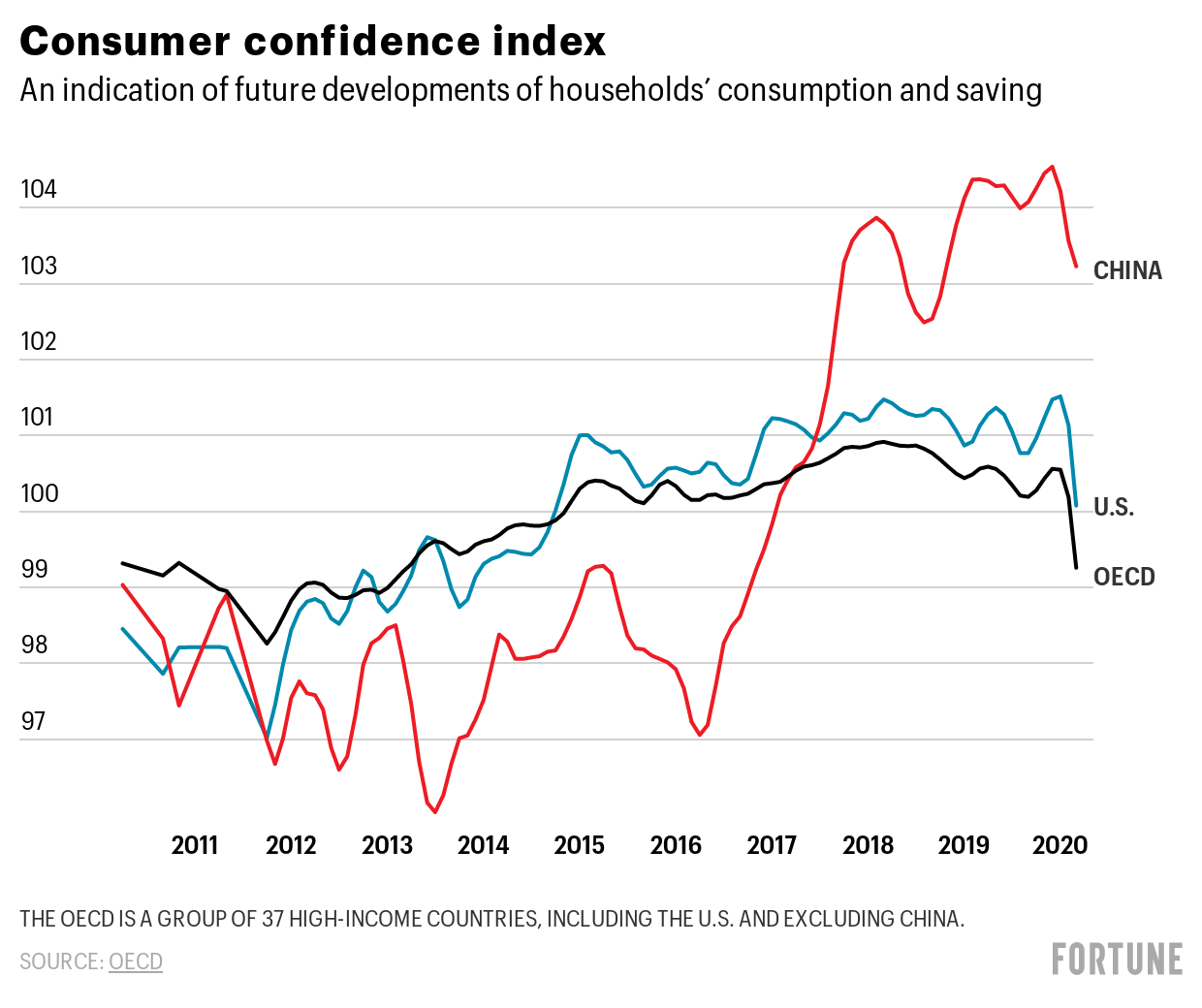5月5日,上海市委、市政府举办了“五五购物节”,推出打折活动,并延长商店营业时间,以期提振消费信心,释放消费潜力,弥补新冠疫情带来的经济损失。
由中国银联联合支付宝、财付通为本次五五购物节提供的实时数据显示,购物节启动后的24小时内,上海地区消费支付总额达156.8亿元。
国家统计局公布的今年一季度居民人均消费支出数据显示,上海人均消费位居全国第一,“买买买”力最强。
随着疫情形势的缓解,中国逐渐放松对旅行业的限制,商店和餐馆开始重新营业,地方政府都在大力助推消费经济复苏。很多省政府通过发放假期优惠券和折扣券的方式刺激消费。武汉市副市长李强甚至开了现场直播,向广大市民推荐他最喜欢的面条店。
他说:“现在武汉的封锁已经解除,餐馆也开张了,我们可以出去吃顿丰盛的早餐。”
不过,类似“五五购物节”活动,以及广州爱马仕专卖店重开当日销售额就突破270万美元的事件,可能并不意味着中国“报复性”消费已经到来。专家预测,经济的不确定性、失业率的上升以及民众对新冠病毒传播的担忧,将使中国消费经济很难在2021年第一季度之前恢复到原来水平。
过去十年,中国中产阶级的数量大幅增加,人们的购买能力随之提高。2019年,中国已超过美国成为世界第一大消费市场。
“由于中美贸易争端,中国在出口方面已经损失了很多GDP,为了弥补这一赤字,中国政府想要促进本地消费。”普华永道消费市场行业亚太区及香港/中国内地主管合伙人郑焕然表示。
麦肯锡对中国国家统计局的数据进行汇编后发现,尽管贸易争端使中国零售额增速放缓,但是自争端开始到2019年9月,消费者的信心却在不断增强。
由经合组织(OECD)编写的消费者信心指数中,中国的数值虽然受疫情影响有所下降,但3月仍保持在100以上(4月数据尚未出炉)。这一临界值表明,即使在疫情期间,中国消费者仍然更倾向于消费。相比之下,美国消费者的信心指数从去年12月的101.47下降至今年4月的98.60。

“尽管可能有第二轮新冠疫情的爆发,但中国是第一个开始经济复苏的国家。”郑焕然指出,“我认为这是中国消费者信心指数一直居高不下的原因。”
疫情对消费的影响
新冠疫情可能是有史以来对中国消费经济的最大威胁。今年4月,中国社会消费品零售总额同比下降7.5%,全国城镇调查失业率为6.0%,比3月上升0.1个百分点。
受疫情影响,中国经济出现1976年以来的首次缩水。西南财经大学调研报告显示,超过40%的家庭会增加储蓄并减少消费。根据国家统计局的数据,今年第一季度,全国人均消费支出实际下降了12.5%。
“中国的消费将出现反弹,但它不会是报复性消费,而是恢复性消费。”数字营销公司Alalice的创始人阿什利·杜达列诺克说。
报复性消费指的是,一旦中国企业重新开业,人们的消费需求在经过一段时间的压抑后,会有一段大的释放和反弹。
然而,阿什利·杜达列诺克认为,“大多数人会不可避免地因为收入减少甚至失业而感到焦虑,”从而导致更多的“理性消费”。
根据淘宝天猫的数据,5月初,家用电器和炊具的销售额分别同比增长196%和89%,天猫图书的销量同比增长24%。而经济图书的销量同比增长45%。与此同时,一季度电子商务销售额同比增加了5.9%,实体商店的销售额同比下降超过20%。
阿里巴巴旗下物流服务公司菜鸟的数据显示,五一劳动节期间的网购订单与2019年同期相比,增加了45%。
郑焕然表示,在地方政府激励措施与电子商务公司折扣活动的推动下,5月第一周的消费者支出使商业经济“恢复了80%至90%”。
他还指出,在未来一段时间内,消费者可能不会继续保持这样的消费水平,这取决于全球经济的状况,“消费经济可能会在6月或7月开始出现小幅下降。”(财富中文网)
编译:于佳鑫
5月5日,上海市委、市政府举办了“五五购物节”,推出打折活动,并延长商店营业时间,以期提振消费信心,释放消费潜力,弥补新冠疫情带来的经济损失。
由中国银联联合支付宝、财付通为本次五五购物节提供的实时数据显示,购物节启动后的24小时内,上海地区消费支付总额达156.8亿元。
国家统计局公布的今年一季度居民人均消费支出数据显示,上海人均消费位居全国第一,“买买买”力最强。
随着疫情形势的缓解,中国逐渐放松对旅行业的限制,商店和餐馆开始重新营业,地方政府都在大力助推消费经济复苏。很多省政府通过发放假期优惠券和折扣券的方式刺激消费。武汉市副市长李强甚至开了现场直播,向广大市民推荐他最喜欢的面条店。
他说:“现在武汉的封锁已经解除,餐馆也开张了,我们可以出去吃顿丰盛的早餐。”
不过,类似“五五购物节”活动,以及广州爱马仕专卖店重开当日销售额就突破270万美元的事件,可能并不意味着中国“报复性”消费已经到来。专家预测,经济的不确定性、失业率的上升以及民众对新冠病毒传播的担忧,将使中国消费经济很难在2021年第一季度之前恢复到原来水平。
过去十年,中国中产阶级的数量大幅增加,人们的购买能力随之提高。2019年,中国已超过美国成为世界第一大消费市场。
“由于中美贸易争端,中国在出口方面已经损失了很多GDP,为了弥补这一赤字,中国政府想要促进本地消费。”普华永道消费市场行业亚太区及香港/中国内地主管合伙人郑焕然表示。
麦肯锡对中国国家统计局的数据进行汇编后发现,尽管贸易争端使中国零售额增速放缓,但是自争端开始到2019年9月,消费者的信心却在不断增强。
由经合组织(OECD)编写的消费者信心指数中,中国的数值虽然受疫情影响有所下降,但3月仍保持在100以上(4月数据尚未出炉)。这一临界值表明,即使在疫情期间,中国消费者仍然更倾向于消费。相比之下,美国消费者的信心指数从去年12月的101.47下降至今年4月的98.60。
“尽管可能有第二轮新冠疫情的爆发,但中国是第一个开始经济复苏的国家。”郑焕然指出,“我认为这是中国消费者信心指数一直居高不下的原因。”
疫情对消费的影响
新冠疫情可能是有史以来对中国消费经济的最大威胁。今年4月,中国社会消费品零售总额同比下降7.5%,全国城镇调查失业率为6.0%,比3月上升0.1个百分点。
受疫情影响,中国经济出现1976年以来的首次缩水。西南财经大学调研报告显示,超过40%的家庭会增加储蓄并减少消费。根据国家统计局的数据,今年第一季度,全国人均消费支出实际下降了12.5%。
“中国的消费将出现反弹,但它不会是报复性消费,而是恢复性消费。”数字营销公司Alalice的创始人阿什利·杜达列诺克说。
报复性消费指的是,一旦中国企业重新开业,人们的消费需求在经过一段时间的压抑后,会有一段大的释放和反弹。
然而,阿什利·杜达列诺克认为,“大多数人会不可避免地因为收入减少甚至失业而感到焦虑,”从而导致更多的“理性消费”。
根据淘宝天猫的数据,5月初,家用电器和炊具的销售额分别同比增长196%和89%,天猫图书的销量同比增长24%。而经济图书的销量同比增长45%。与此同时,一季度电子商务销售额同比增加了5.9%,实体商店的销售额同比下降超过20%。
阿里巴巴旗下物流服务公司菜鸟的数据显示,五一劳动节期间的网购订单与2019年同期相比,增加了45%。
郑焕然表示,在地方政府激励措施与电子商务公司折扣活动的推动下,5月第一周的消费者支出使商业经济“恢复了80%至90%”。
他还指出,在未来一段时间内,消费者可能不会继续保持这样的消费水平,这取决于全球经济的状况,“消费经济可能会在6月或7月开始出现小幅下降。”(财富中文网)
编译:于佳鑫
On May 5, Shanghai city officials launched the "Double Five" shopping festival, offering hefty discounts and extended store hours for the next two months in an attempt to boost spending and make up for the losses caused by the coronavirus pandemic.
Combined sales—at both online and offline retailers—reached $2.2 billion in the first 24 hours of the "Double Five" shopping event (named for the date it started), according to the Shanghai Commerce Commission.
Shanghai has China's most prolific shoppers—it ranked No. 1 in the country for per capita consumption expenditure during the first quarter of 2020.
As China eases out of coronavirus-induced travel restrictions and as shops and restaurants begin to reopen, local governments are pushing to get consumer spending—which makes up nearly 60% of gross domestic product growth in China—to pre-pandemic levels.
Provincial governments issued $2.69 billion in coupons and discount vouchers to stimulate spending during the Labor Day holiday in the first week of May. Wuhan's deputy mayor even held a live-streaming event urging residents to patronize his favorite noodle shop.
"Now the lockdown is lifted and restaurants are opening, we can go out and have a nice breakfast," he said.
But brief spurts of spending—like the "Double Five" event and the $2.7 million that luxury retailer Hermes earned on the day it reopened in Guangzhou in April—may not translate to an immediate, sustained recovery for the world's largest consumer economy. In fact, experts predict economic uncertainty, rising unemployment, and lingering fears about the spread of the virus will keep China's consumer economy from returning to pre-pandemic levels until at least the first quarter of 2021. The wary, newly thrifty attitude is a stark departure for shoppers who, until the coronavirus hit, had been among the world's most confident.
In the last ten years, rising household incomes expanded China's urban middle class. More people gained more purchasing power, and in 2019 China overtook the U.S. to become the world's largest consumer market, to the delight of Beijing.
"Because of the China-U.S. trade dispute, China has already lost a lot of GDP in terms of export, so to try to compensate for this deficit, the Chinese government really wants to boost local consumption," said Michael Cheng, consumer markets leader for Asia Pacific, Hong Kong, and mainland China at professional services firm PwC.
Even as China's year-on-year retail sales slowed with the advent of the U.S.-China trade dispute in 2018 and 2019, consumer confidence increased between the start of the feud and Sep. 2019, according to data compiled by McKinsey from China's National Bureau of Statistics.
China's consumer confidence score, based on the Organization of Economic Co-operation and Development's index, dipped due to the coronavirus but remained above 100 in March (China's data for April is not yet available), a threshold that indicates consumers are more inclined to spend. U.S. consumers, by comparison, contribute around 70% of economic activity, and saw their confidence score drop from 101.47 in December to 98.60 in April.
"Notwithstanding that there might be a second round or revival of the virus, China is the first country to start to recover," Cheng said. "That's why I think the consumer [confidence] index will still be high."
Coronavirus's threat to consumption
The coronavirus, and the subsequent mass lockdowns of business and society, arguably represent the biggest-ever modern-day threat to China's consumer economy. Retail sales fell 7.5% year-on-year in April, higher than the forecast 7% decline as the official urban unemployment rate rose to 6%, compared to March's 5.9% and the 4% to 5% rate of normal years.
China's GDP contracted for the first time since 1976 this year because of the pandemic, and a March survey by China's Southwestern University of Finance and Economics found that over 40% of households planned to reduce their consumption in 2020, while per capita consumption expenditure dropped 12.5% from the year before.
"Consumption [in China] will bounce back, but it won't be revenge consumption, [it will be] recovery consumption," said Ashley Dudarenok, founder of Alarice, a Hong Kong-based digital marketing firm that focuses on mainland China.
Revenge consumption refers to the idea that once businesses reopen in China, consumers will rush to make up for lost time by spending even more.
"For most people, it is inevitable that there will be anxiety about income reduction or even unemployment," leading to more "rational consumption," Dudarenok said.
Indeed, data from Tmall, an online retailer operated by Alibaba Group, showed that sales of home appliances and cooking appliances respectively increased by 196% and 89% in early May compared to the same period last year, and book sales increased by 24%. E-commerce sales, meanwhile, climbed 5.9% year-over-year in the first three months of 2020, when almost everyone was at home under lockdown; physical stores saw sales decline by more than 20%.
Restrictions had eased across most of China by April, but during the Labor Day holiday in early May, when many people were still at home, online shopping orders increased by 45% compared to the same period in 2019, according to data from Alibaba-owned logistics company Cainiao.
Cheng said consumer spending in the first week of May—bolstered by local government incentives and e-commerce company discounts—brought business "80–90% back to normal."
But, Cheng said, consumers might not continue spending at these levels for a sustained period of time, and depending on the state of the global economy, "business will start to go down a little maybe in June or July again."






